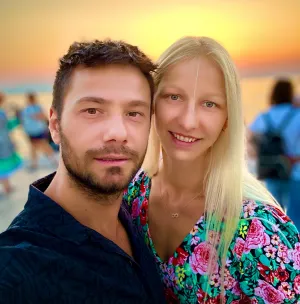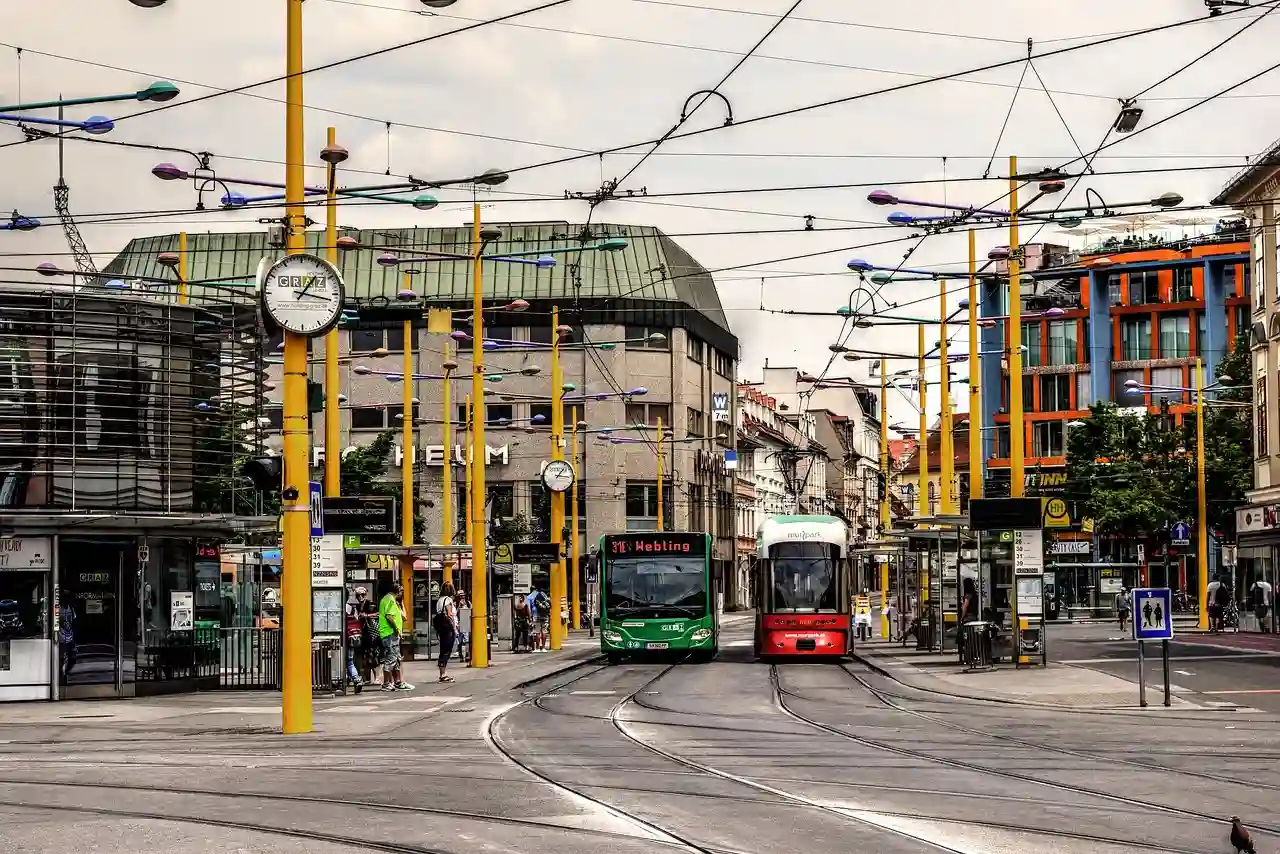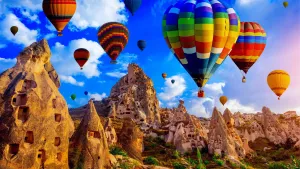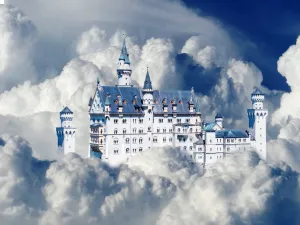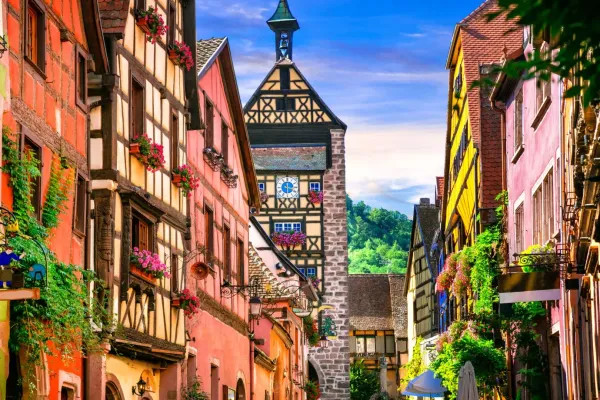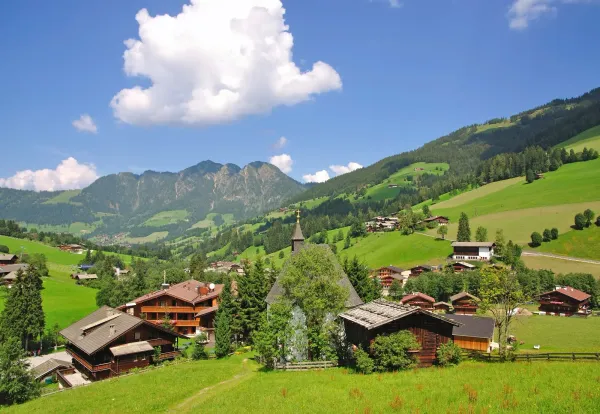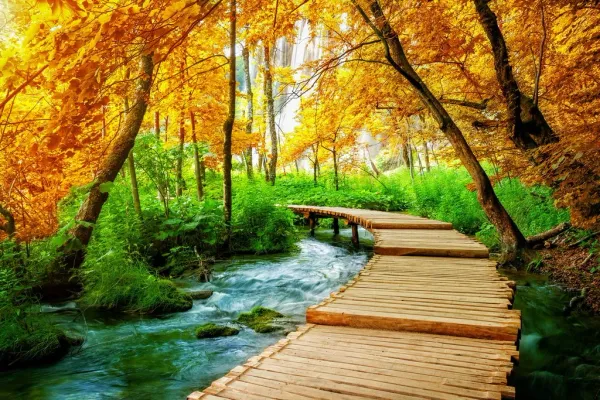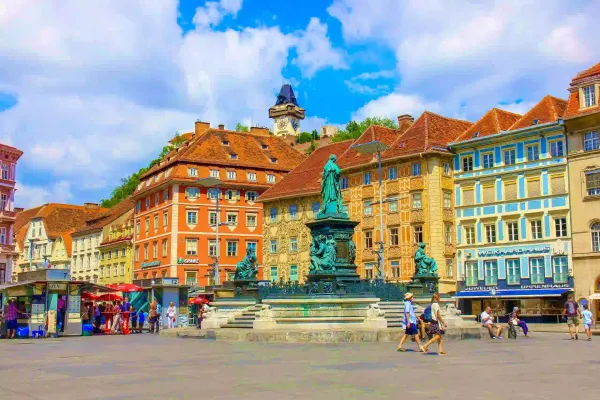Beautiful and historic Graz is the capital of the Styrian region as well as the second largest city in Austria after its capital Vienna. It is located in the southeast of the country, on the banks of the Mur River, very close to the borders of Slovenia and Hungary.
Graz is nestled about 350 meters above sea level and is surrounded from the west, north, and east by mountains and hills that make it undeniably attractive and also protect it from cold winds, while warm air flows in from the south giving it a slightly Mediterranean atmosphere.
Graz is particularly popular among students, offering them several Universities and Colleges. People say that every 6th of its inhabitants is a student, and this is perfectly reflected at night when the nightlife is in full swing.
In addition, such popular personalities as the famous actor and former governor of California Arnold Schwarzenegger, and the Austrian songwriter, conductor, and composer Robert Stolz come from Graz.
As well as the famous electrical engineer Nikola Tesla, who only studied in Graz.
Although Graz is quite far from Austria's main cities like Vienna or Salzburg, it is quite convenient and quick to reach.
There are direct trains and buses from Vienna and Salzburg to Graz. In addition, Graz also has an airport, so it can also be reached from some other countries by direct plane.
Moreover, Graz is located only 70 kilometers from Slovenia's second largest city, Maribor, situated along the banks of the Drava River.
With a relatively close distance, this lovely, historic Slovenian town deserves to be included as a day trip destination from Graz.
On your trip to Graz, a whole series of fascinating attractions awaits you at every corner.
After all, the entire Old Town of Graz has been a UNESCO World Heritage Site since 1999, and its old town center is one of the best-preserved in central Europe.
And if that's not enough, in 2003 Graz was nominated as the "European Capital of Culture" offering art, culture and other events to locals and visitors all year round.
And thanks to the skills of the chefs and the excellent food ingredients produced right there in the Graz area, in 2008 it was nominated as "GenussHauptstadt", or "Austrian Capital City of Culinary Delights".
And what's more, since 2011 Graz has been part of the UNESCO Creative Cities Network as a "City of Design" due to its many examples of contemporary architecture, as well as the city's ability to immerse itself in design and creativity.
Stunning shopping streets, fresh green river banks and parks, elegant palaces, countless museums, historic and futuristic buildings, exciting nightlife and delicious food await you in Graz.
In this guide, we'll cover the top attractions and things to do, all the important information and tips that will come in handy when visiting Graz, Austria.
1. Old Town of Graz
Strolling through the Old Town of Graz dominated by the impressive Clock Tower, which is also the symbol of the city, its visitors will discover hidden alleys, countless romantic courtyards, elegant facades as well as winding cobbled streets with countless luxury fashion shops, museums, bars, restaurants, clubs and stunning sights.
Good to Know!
The most convenient way to move around Graz's old town center is to use the city tram. And thanks to the "Altstadt Bim" campaign, everyone can use the tram for free to move around the city center.
Although the center of Graz is easily accessible on foot without missing special masterpieces, this excellent option is very useful to see and visit as much as possible, especially when the weather is not conducive to walking or you only have one day to explore the city.
In order to recognize the free zone of the tram, there is a sticker - "Altstadt Bim" Free ride - placed at the stops.
Read also: 19 Top places to visit in Austria
2. Main Square (Hauptplatz)
The highlight is the Main Square, one of the main features of which is a fountain with a statue of the Styrian prince, the Archduke Johann.
Also, the Main Square is lined with historically beautiful buildings, such as the Graz Town Hall, which dominates the southern part of the square. This Late Historicist-Old German-style building was built at the end of the 19th century, replacing several other buildings.
From the outside, it is decorated with statues representing the prominent Habsburg emperors and sculptures dedicated to art, science, commerce and industry.
On the inside, admire the luxurious interior, which has preserved stunning coffered ceilings, Fresco-Secco paintings, pot stoves in the old German style, chandelier and wall clock from the 19th century, and portraits of historical figures.
Moreover, everyone can visit it completely free.
The Graz town hall houses a wedding hall, the municipal council's meeting hall, the mayor's office, the Senate's meeting room, and a visitors' gallery.
The historical landmark Luegg House (Haus am Luegg), a building located on the Main Square on the corner of Sporgasse, cannot be overlooked. It dazzles visitors with a stunningly beautiful baroque stucco facade built in the 17th century.
The main square was redesigned in 2002 to include a large square in front of the town hall, which is used for various events throughout the year, including Christmas markets and the Sound Light Festival Graz (Klanglicht Graz) which takes place over three days in October, as well as a culinary event which usually takes place in August - The Long Table.
3. Stroll through Herrengasse - Graz’s Main Street
From Main Square, stroll along Graz's most elegant street, Herrengasse, Graz's main shopping mile with the best international brands.
In addition, it is filled with stunningly elegant architecture, as one noteworthy building in Herrengasse is the Painted House, or Gemaltes Haus in German. It is hard to miss because its four-story facade (about 200 square meters) is painted with magnificent frescoes depicting Greek and Roman deities.
The arcades of the Italian Renaissance masterpiece Landhaushof are also impressive. In addition, the State Armory is also located here, which displays the world's largest historical collection of weapons.
Other shopping streets in Graz include the romantic cobbled Sporgasse street, along which you will find elegant buildings, as well as the oldest city courtyard and parish church.
Stempfergasse pedestrian area opposite the Landeszeughaus across Herrengasse, and Schmiedgasse, the main pedestrian area in Graz filled with cafes and bars.
Schmiedgasse, like Herrengasse and Sporgasse, leads from Graz's main square.
4. Take a look into Landhaus Courtyard
One of the most beautiful courtyards, which actually consists of three courtyards, a must-see in Graz is the Landhaus courtyard.
In addition, Landhaus Courtyard can be visited by anyone absolutely free of charge.
This elegant Italian Renaissance building, somewhat reminiscent of the Doge's Palace in Italy, is located very close to Graz's Main Square and is one of the most important buildings in the Styrian region, built in the 16th century by the famous Italian Renaissance architect Domenico dell'Allio.
From the outside, it looks like a simple Italianate building with ornate arched windows.
But from the inside it impresses with a Renaissance-style 3-story inner arcaded courtyard.
The courtyard is complemented by the historic bronze fountain gazebo - a Mannerist masterpiece, a mythical bronze statue, a bell tower and a green wooden gate with a white heraldic panther with red horns and claws, by the way, this creature is also depicted in the Styrian coat of arms.
The courtyard of the Landhaus is also a place where various events take place, and during Advent it is home to an ice Nativity scene, which is also stunningly illuminated together with the courtyard, giving it a special charm.
Be sure to also explore the Landhaus itself, where the Styrian state government meets. Its baroque rooms are richly decorated with stucco and luxurious furniture.
There is also a country house chapel that can be visited by those interested.
In addition, there is also a restaurant in the building, which has a beautiful terrace in the courtyard.
5. Marvel at the Landeszeughaus - Armory Museum
After viewing the Landhaus Courtyard, find your way to the Landeszeughaus, whose entrance is from Herrengasse.
In the Landeszeughaus museum, visitors can view various types of military weapons that have been preserved since the 15th century.
The Landeszeughaus is one of the largest and most important museums of its kind in the world, with more than 31,000 pieces of historical military equipment, including meticulously maintained various types of swords, pistols, axes, spears, gun armor, horse armor, shield sets, cannons, mortars and much more military equipment parts.
The museum is housed in a four-story armory that is perfectly preserved from the mid-17th century and was once a very important arsenal in the southeast for the Habsburg Empire.
In the 18th century, when the arsenal was no longer so important, the Austrian empress Maria Theresia wanted to close the armory, but at the request of the Styrian nobles, it was preserved as a "monument to the history of the country", which was opened to the public in 1982.
The Landeszeughaus Armory Museum is a real paradise for history and weapon lovers.
Good to Know! The entrance to the museum costs 11 euros for an adult, but children under the age of 19 can visit it for free, and there are also discounts for students and others. (as of 2023)
And for those who want to learn more about armor, its origin and history, it is highly recommended to join the tour or buy an audio guide.
The museum is open from April 1 to October 31, from 10 a.m. to 6 p.m. every day except Mondays and some holidays.
Unfortunately, from November 1 to April 31, the armory is only available with a guided tour.
6. Glockenspielplatz - Dancing Clock
A walk through the Old Town of Graz will also take visitors to the Glockenspielplatz, home to Graz's historic landmark, the Glockenspiel, also known as the Graz Carillon.
The carillon was installed in the very first years of the 20th century, at the house of Gottfried Maurer, a famous beverage manufacturer at that time.
Several years later, it gifted it to the city of Graz on the condition that the carillon continue to operate.
The condition was also fulfilled, with the exception of World War II when its operation was suspended and the bells of the tower were invested in the production of weapons.
In 1956, the bells of the tower were restored and the carillon started working again and until today it plays three different melodies three times in a day (11:00, 15:00 and 18:00).
At the beginning of the melody playing, two glass doors open, from which two wooden figures (a couple) emerge and dance along with the melody.
At the end of the performance, the carillon dancer toasts his audience and the golden rooster above the clock flaps its wings and crows.
Glockenspielplatz is one of the most popular squares in Graz, filled with terraces where visitors can enjoy something delicious along with a carillon show.
7. Graz Cathedral
Graz Cathedral is a royal imperial church that harmoniously combines Gothic and Baroque elements and should not be missed when visiting Graz.
The cathedral is located only about a minute's walk from Glockenspielplatz next to Graz Palace.
It was built in the Gothic style on the order of Emperor Frederik III in the middle of the 15th century, but restored in the Baroque style at the end of the 17th century.
The exterior of the cathedral looks very simple, except for the ornate tower and golden spire, although during the Gothic period its facade was decorated with frescoes, of which only one has survived - the Gottesplagenbild, meaning "God's Plagues".
This fresco depicts terrible years in the city's history and can be found on the south exterior wall near the entrance to the Mausoleum of Ferdinand II.
The interior of the cathedral is decorated with a vaulted ceiling and frescoes. Inside visitors will admire many historical and ecclesiastical treasures like an ornate high altar, Renaissance relic chests with ivory reliefs and the beautiful cathedral organ.
Also impressive is the late Gothic crucifixion panel, considered one of the most impressive of its kind in all German-speaking countries.
Graz Cathedral is open every day and there is no entrance fee to visit it.
More churches in Graz
Franciscan Monastery: Graz Cathedral is a must-visit for everyone, but for those who like churches and are closely connected to faith, there are also other churches in the city, such as the 13th century Franciscan Monastery with its Church located on Franziskanerplatz, between the Mur River and the Main Square of Graz.
The Franciscan monastery is the oldest monastery in Graz and visitors can wander around the Gothic monastery and its small charming rose garden as well as visit the catolic church completely free of charge.
Parish Church: There is also the historical Parish Church located on Herrengasse street.
By the way, it houses one of the best organs in the entire Styrian region, whose melody can be heard at organ concerts, church services and at lunchtime during the summer period.
Be sure to pay attention to the stained glass windows that once caused a great stir, they are located behind the altar and show the faces of Hitler and Mussolini.
Mariahilfkirche church: Then there is the Mariahilfkirche church with its Minorite monastery.
Admire the stucco decorations, ceiling frescoes, cloister rooms and the lovely arched courtyard. Mariahilfkirche is located on the other side of the Mur River, a few minutes' walk from the impressive Kunsthaus Graz and the Mur River Island.
St. Andrä church: The completely different and unusual St. Andrä church located on Kernstockgasse street.
St. Andrä's church differs in that its exterior is covered with stylish graffiti inscriptions, so that at the first moment it won't seem like it could be a church where a service is held, but it is.
In addition, the interior walls of the church are also covered with graffiti inscriptions. An interesting sight that is recommended for everyone.
Herz-Jesu-Kirche: As well as the relatively new neo-Gothic Herz-Jesu-Kirche, which was built in the 19th century and is located on the Sparbersbachgasse street.
This is by the way the largest church in Graz, with a 109.6 meter high church tower, which is the third highest in Austria.
8. Mausoleum of Emperor Ferdinand II
Next to the Cathedral of Graz is the impressive mausoleum of Emperor Ferdinand II, which complements the city landscape with its turquoise domes.
The Mausoleum of Emperor Ferdinand II is one of the most important monuments in Graz and throughout Austria.
The mausoleum, reminiscent of the successful counter-reformation, consists of two parts - in the north is St. Catherine's Church, but in its southern part there is a mausoleum, which is the burial place of Emperor Ferdinand II and his family members.
The construction of the mausoleum began at the beginning of the 17th century, but was not fully completed until the end of the century.
Its facade is decorated with impressive sandstone sacred statues, columns, frescoes and stucco.
The interior, which has a strong Italian influence, is as impressive as the exterior. Here you will find sumptuous works of art, statues, stunning frescoes, incredibly intricate carvings, as well as tombs.
In addition, there is an opportunity to climb the bell tower of St. Catherine's Church via the spiral staircase.
9. Twin Spiral Staircase - Doppelwendeltreppe
One of the most interesting sights in Graz, which is definitely worth a visit.
This late Gothic masterpiece dating from the 15th/16th century is located in Graz Castle in the so-called Graz core, which is also the seat of the Styrian state government.
Known to the locals as the 'Reconciliation Stairs', it consists of two symmetrically identical stone staircases that spiral in opposite directions and converge at each floor and separate again at the same time, creating a surprising illusion.
The staircase, freely accessible to everyone, is one of the most architecturally significant twin spiral staircases in Europe.
From the top there is a beautiful view of the courtyard with the castle garden and the mausoleum of Emperor Ferdinand.
A must-see for architecture lovers and photographers in Graz!
10. Visit the Kunsthaus Graz (Modern Art Museum)
The famous landmark of the city of Graz, the Kunsthaus stands out for its ultra-modern and contemporary architectural style.
The building, which locals and tourists often refer to as a friendly alien, a spaceship or a body organ, was built in 2003, when Graz was the Capital of Culture.
With its biomorphic form, it really resembles some kind of creature that even emits sound waves at the 50th minute of every hour.
From the outside, the impressive building is covered with glowing dark blue acrylic panels equipped with light installations, and with the help of software, images and texts can be displayed on the building, as well as simply beautifully illuminated in the dark of the day.
The inside of the building is just as amazing as the outside. Although as a museum it is quite different from other museums in Graz, as there are no independent exhibitions here.
Its contemporary exhibitions and art projects regularly change approx. every 3-4 months, and its premises are dominated by modern technologies.
In addition to exhibitions and art projects, this Friendly Alien is also home to a tasteful Kunsthaus-Café and a shop that offers products specially suited to the museum.
It is definitely worth climbing up to the top floor where there is a viewing platform, known in the museum as "the needle".
From the viewing platform there are nice views of the city of Graz.
Good to Know!
Friendly Alien is open to visitors from Tuesday to Sunday and on public holidays from 10 a.m. to 6 p.m.
The entrance ticket for an adult costs 11 euros, and entry is free for children under 19 years of age.
11. Cross the Murinsel (Mur Island)
Another architectural wonder of Graz. Murisland is a man-made island about 50 meters long, located in the middle of the River Mur, and it connects both banks of the river with bridges.
Like the Friendly Alien, the modern floating structure, designed by American designer and artist Vito Acconci, was created in honor of Graz's European Capital of Culture year in 2003.
Made of steel and glass, Murinsel is not only a modern designed island, it is home to a cozy Cafe where you can take a break and enjoy delicious drinks and snacks, a gift shop where you can buy original gifts to take home, and a small children's playground.
In addition, various cultural events, atmospheric concerts and open-air cinema evenings take place in the amphitheater created on the island of Mur.
The shell-shaped island stands out especially in the dark when it is illuminated and, together with the gurgling river waters, creates a special mood.
12. Explore the Schlossberg Hill
Schlossberg is not to be missed when visiting Graz! Located in the middle of Graz as part of Graz's Old Town, this 473-meter-high hill, along with Graz's landmark, the Clock Tower, is one of the city's most popular sights and a great backdrop for any Graz photo.
The top of the Schlossberg, where there is a park with various attractions, can be reached in several ways: by lift, cable car or on foot.
The Felsensteig panoramic trail, which starts from Schlossberg Platz (Schlossberg Square), is one of the best ways to reach Schlossberg.
A steep, zigzag staircase with more than 250 steps is carved into the rock, with viewing platforms at several points so you can enjoy the beautiful panoramic view of the city again and again along the way.
In addition, easier paths than steps lead from Wickenburggasse street on the north side of the hill, from Karmeliterplatz (at the end of Sporgasse street) on the south side of the hill through illuminated tunnel inside the Schlossberg, as well as some trails from the east side of the hill.
If you don't want to climb up on foot, the fastest way to get to Schlossberg is by taking the Schlossberg lift to the Graz Clock Tower.
In less than one minute, enjoy the view of the illuminated mountain shaft through the glass cabins of the elevator.
The price of the journey is 2 euros for adults and 1.50 for children aged 6-14. (as of 2023)
The next way to get up is via the Schlossbergbahn funicular in about 4 minutes.
The railway funicular with a 60% gradient and a glass roof offers a great view of the city of Graz.
The lower station of the Schlossbergbahn is about 230 meters further north beyond Schlossberg Platz.
Prices for the journey vary from 2.70 to 5.80 per adult, depending on which plan you choose.
Cheaper tickets for children, students, seniors and people with mobility impairments.
Formerly the site of a fortress and only later transformed into a public park, the tree-lined Schlossberg is a place where locals enjoy the freshness of spring, catch the breeze in the hot summers, enjoy the colors in autumn, and escape the grayness of the city in winter.
In addition to the fantastic views from Schlossberg, in its park visitors can find and admire attractions such as the Chinese Pavilion, many statues, the historic 34-meter-high Bell Tower, and the main attraction, the Graz Clock Tower.
Schlossberg is also home to the Graz Museum where you can get an insight into the history of Graz, some restaurants and cafes too, a children's playground, and an underground event hall.
Graz Clock Tower
The well-preserved Clock Tower (Uhrturm) is recognized as one of the main attractions of the city of Graz. And not for nothing!
The remarkable 13th-century medieval Clock Tower stands majestically some 120 meters above the Old Town of Graz, offering magnificent views of the city and beyond.
The Clock Tower itself is 28 meters high and has the hands of the clock changed in places, the minute hand being shorter than the hour hand, thus possibly causing a bit of confusion.
In addition, the Clock Tower has three bells, each of which once had its own task. One was used to warn when a fire broke out, another was used when an execution was carried out, and later to remind of the curfew, and the third was used as a striker.
The Clock Tower is a well-known place for locals to enjoy romantic sunsets and sunrises.
Around the clock there is a lovely garden with beautiful flower beds where everyone can enjoy the views or even have a picnic.
Schlossberg slide
Schlossberg is not only a place to enjoy views, romance and food. It also offers some really exciting things to do, like sliding down from the Clock Tower back to the Old Town center.
The Schlossberg slide, or Schlossberg Rutsche as it is known in German, is one of the longest underground slides in the world.
That's right, enjoy sliding from a height of about 64 meters through a 175-meter-long tunnel located inside the mountain.
The slide lasts approx. 40 seconds, during which you can experience speeds of up to 30 km per hour.
The Schlossberg slide is fun for both young and old, but unfortunately, for safety reasons, it can only be used by those whose height has already reached 130 cm.
The descent costs 6 euros, and at the end it is possible to buy a photo captured by the speed camera (costs about 3 euros).
The Graz Fairytale Train (Märchenbahn)
Another Schlossberg attraction. An attraction that will take visitors through the tunnels that were once created inside the mountain to protect the citizens of Graz during World War II.
Since then, some of these mountain shafts have been popular tourist attractions in Graz.
During this journey (approx. 30 min.), visitors will travel on a small train through tunnels/shaktas that are artistically illuminated and accompanied by music.
The temperature in the tunnels is around 8-12 degrees, even in summer, so be sure to take some warmer clothes.
The entrance fee is 8.50 for an adult and 6.50 for a child under 14 years old. (as of 2023)
13. Visit Eggenberg Castle
Since 2010, the magnificent Eggenberg Castle complex has been included in the UNESCO World Heritage List "City of Graz - Historic Center and Eggenberg Castle".
Eggenberg Castle is built based on the Gregorian calendar. Its 4 towers, 365 external windows, 52 piano noble windows, 24 state rooms, and exactly 31 rooms on each floor, symbolize the seasons, days of the year, weeks of the year, days of the month and hours in one day.
A special highlight of Eggenberg Castle is a visit to the cycle of 24 State Rooms, all of which are still in their original appearance from the 17th and 18th centuries.
All rooms have more than 500 wall and ceiling paintings depicting world history including Greek and Roman mythologies, religious scenes from the Bible and historical legends.
In addition to paintings, the rooms are decorated with exquisite furniture, valuable porcelain dishes, Chinese silk paintings, Japanese folding screen panels, luxurious chandeliers, which, by the way, have not been electrified until today, which means that if you get to see the palace in semi-darkness, you will fully enjoy its atmosphere by candlelight.
Particularly impressive is the magnificent baroque Planetary Hall, completed in 1685, which serves as the beginning and end of the magnificent cycle of rooms.
As the name suggests, the main focus of this room is based on astrology. In its paintings, there are distant scenes with the planets, which at that time only 7 were known, and the signs of the zodiac.
In the palace you can also visit three valuable collections of the Universalmuseum Joanneum: the archeology museum, the coin cabinet and the old gallery, which exhibits masterpieces of art from the Middle Ages to the Enlightenment.
The Palace Park with its majestic peacocks, showing off their colors, also invites you to linger.
The complex, created in the 17th century as a baroque garden, has developed over the centuries into a large landscaped park with a collection of valuable trees.
A particular highlight is the Rose Hill, centered around 350 historic roses, all imported before 1835.
Also, the Herrschaftsgartel private park created in the 19th century at the back of the palace, the Planet garden located in the northern corner of the Eggenberger Park, the Biedermeier flower garden in front of the southern pavilion, as well as the orchard with 50 historical varieties of apples and pears cannot be overlooked.
With so much to see and do at Eggenberger Castle, you should definitely plan several hours to enjoy all that the baroque castle and its beautiful park have to offer.
Good to Know!
Eggenberg Castle is located just under 5 kilometers from the old town of Graz and can easily be reached by tram using tram 1 (stop: Schloss Eggenberg) and 7 (stop: Eggenberger Allee/tim or Absengerstraße).
Excursions through the State Rooms take place only with a guide at a certain time, from 10 am to 4 pm, every hour except at 1 pm. From May to September, also at 5 pm.
The entrance fee, which includes the guide, is 17 euros for adults and children under 19 are free.
7 euros for students between 19 and 26 years of age.
2 euros in addition to visiting the park.
14. Get to Know Arnold Schwarzenegger Closer
Probably everyone knows the famous actor Arnold Schwarzenegger, the main actor of the Terminator movie.
But did you know that he was born and raised in Graz?
That's right, in 1947, the international star Arnie was born in the former forester's cabin of Count Herberstein in the village of Thal, which is very close to Graz, and the house now houses the only museum in his honor.
Arnold is not just a popular and well-known actor. He started his career as a bodybuilder, and to this day is known as the most successful bodybuilder of all time, who won the titles of Mister Olympia 7 times and Mister Universe 5 times.
In addition, he is also a politician who served as the 38th Governor of California from 2003 to 2011.
When you visit the Arnold Schwarzenegger Museum, you will have the opportunity to enter the house where he was born and spent his childhood.
The many exhibits reveal his extraordinary life journey, as well as the highlights of his life, such as childhood and youth, bodybuilding, film career, and governorship.
Good to Know!
The museum is open every day from 10 am to 6 pm in the summer months between March and October, and in the other months until 5 pm.
The entrance fee is 8.90 for adults, 3.90 for children from 5 to 14 years, and 6.90 for pupils and students up to 27 years of age. (as of 2023)
Hasta la vista, baby!
15. Parish Church of St. Jacob in Thal
Do you want a completely different church experience? Then, the Parish Church of St. Jacob, located very close to the Arnold Schwarzenegger Museum, should definitely be on your must-see list.
By the way, Arnold Schwarzenegger was baptized in this church before it was remodeled.
It stands out architecturally both with its unusual exterior and its interior.
Although the church dates back to the 14th century, it became especially popular only after 1994, when it was rebuilt by combining the old church with new additions.
Its design, artistically designed by Ernest Fuchs, gives it a special charm, which is why this tourist magnet is sometimes called the Fuchs Church.
In front of the church rises a rosy-colored tower, and behind it turquoise-blue roofs that shine beautifully in the sun.
As you approach, you will be able to see that the exterior walls of the church are decorated with shimmering images made of gravel fragments.
Its entrance door also stands out - a thick glass door with ram's horn handles.
The interior is even more fabulously beautiful, though unusual for a church.
A variety of fantastic shapes and colors complemented by light effects. Open roof truss with rainbow colors, uneven pebble floor, benches made of pebbles with scallop motifs, and many other impressive details.
16. Sports, fun and relaxation in Graz’s Parks
Graz is a great city that offers not only a wonderful Old Town center with many historical buildings and shopping and dining options.
It also amazes with the abundance of green areas that are only a step away, whether it is a park or river banks or colorful gardens.
The parks are well structured with long paths for jogging and walking, with skate parks, children's playgrounds, and recreation areas.
Graz City Park
The Stadtpark or City Park is one of the largest parks in Graz.
It is located right in the center of the city and offers its visitors beautiful park paths filled with many statues, flower beds, fountains and benches, several cafes where you can enjoy a cup of drink, lawns where you can lay down a blanket and relax, as well as playgrounds where the little ones can have fun.
Next to the park are also the beautiful palace gardens, or Burggarten, which are slightly hidden from the eyes of tourists.
In the territory of the palace gardens there is a large Orangery where various events take place.
The gardens are open to the public from 8 am to 7 pm and are accessible from the Palace courtyard during the winter.
Not far from the City Park, there is an impressive Opera House, where, although not as often as in Vienna or Salzburg, opera performances take place.
Volksgarten Park
Then there is the Volksgarten on the other side of the Mur River, about a 7-minute walk from the Murinsel and about a 14-minute walk from Graz's Old Town.
The park is divided in half by a canal and in the spring it is dominated by blooming cherry trees and other beauties.
In the territory of the park there is a skate park, table tennis, a street-gym area, a fenced area for dogs, a children's playground, a duck pond - everything you need to actively relax and do sports.
Augarten Park
Next is the Augarten park, which you can reach in about fifteen minutes by walking along the river bank.
Just like the other parks, there is a lot to do in this park, both for children and athletes, and for those who just want to relax.
But in addition, this park is distinguished by the fact that it is located along the river bank, where there are also swimming area.
Also in the Augarten park is the Children's Museum, which is practically like a big indoor playground, where children can learn about the world through interactive play.
As well as near the park, there is also the Augartenbad - swimming pools with slides and trampolines, where you can refresh yourself and have fun on summer days.
Graz Botanical Garden
Take a leisurely stroll through the Botanical Garden of Graz and admire the dynamic colors of plants that come from different climate zones, from the tropics to the desert.
This lovely little botanical garden is cultivated and maintained by the University of Graz. One of the nicest things - there is no entrance fee.
Although, be sure to support with a donation or buy some useful products made from the plants of this botanical garden.
Not far from the botanical park is another Graz park surrounding the Hilmteich pond, where visitors can continue to relax among nature.
The park also has attractions such as the Forest Rope Park, where the whole family can relax and have fun in a different way.
Austrian Sculpture Park
A nice park where nature has merged with the art of contemporary sculpture. It is located approximately 13 kilometers south of Graz.
The sculpture park has more than 80 interesting and fascinating sculptures on an area of 7 hectares, some of which you can even climb on.
In addition, the park also has its own lotus pond and labyrinth. What's more, there is no entrance fee to the park, and parking is free.
A nice place to spend time with and without children, have a picnic and just walk around and enjoy the art.
17. Visit Joanneum Quarter museum complex
The Joanneum quarter or Joanneumsviertel is a large and universal cultural center that combines three buildings from different eras which in turn house the Styrian State Library, Neue Galerie Graz and BRUSEUM, CoSA - Center of Science Activities and Natural History Museum.
The Universal Museum Complex is located in the historic center of Graz between Landhausgasse, Raubergasse, Kalchberggasse, and Neutorgasse and is one of the largest museums of its kind in Central Europe.
Get to know the world of plants, animals, and rocks while walking through the Natural History Museum.
Participate in research works related to technology and natural sciences in CoSA - Center of Science.
See high-quality art from 1800 to the present day in the Neue Galerie and the private collection of the world-renowned Styrian artist Günter Brusam.
And in the Styrian State Library, admire the inexhaustible abundance of books. Everything is next to each other, convenient, fast, and nice.
Good to Know!
By purchasing 24-hour, 48-hour, or Annual tickets you have the opportunity to visit all these museums and exhibitions + more, including Eggenberg Castle and the Landesarsenal, for a very affordable price.
Get more information here.
Overall, Graz in Austria is a really nice city that offers something for everyone, whether you're a history buff, a nature lover, a foodie, or a high-tech fan.
Therefore, Graz should definitely be included in the travel list. And by following our guide, your trip will turn into a nice adventure.
Be sure not to miss our blog post about Places to visit near Graz.

